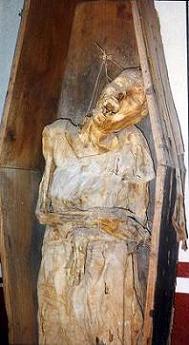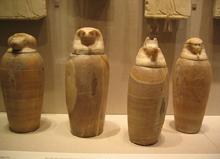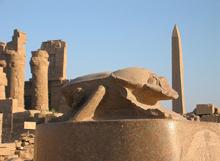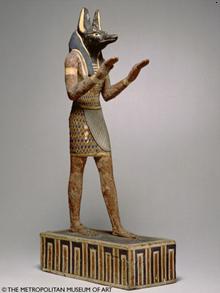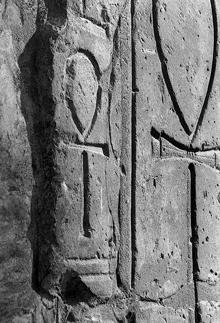13 Things Egyptian your grandchildren will never see
When I was a child in the 50s the greatest monster movies for children were Frankenstein, The Wolfman, Dracula, and The Mummy.
Of those films, The Mummy had the greatest texture with ancient curses, sacred burial tombs, enchanted spells, magic tea leaves, hieroglyphs and a love story. If you've never seen the Mummy, here it is in brief: Boris Karloff plays an Ancient Egyptian priest named Imhotep, whose mummy is accidentally brought to life by an archaeological team. He prowls Cairo looking for the reincarnated soul of his past love, the Princess Ankhesenamun who happened to be the wife of the pharaoh Tutankhamun.
Whenever the Mummy appeared my brother, who was about 7 at the time, would cover his eyes with his hands in fright. Ever since, I've been in love with things Egyptian.
Sadly, as many of you already know, Muslims, modern or ancient, cannot abide the artifacts of any other religion or culture. We recall the destruction of the 1800 year old Bamiyan Buddhas, the tallest standing Buddha statues in 2001 by the Taliban. And in Pakistan Islamic radicals are suspected of bombing the Swat Buddha rock carving that dates back to the 1st Century.
There exists a real danger that Islam will one day destroy the cultural and historical heritage of Egypt:
Truth and Grace,
3 Apr 2006,
Destroy Egypt's Antiquities?A fatwa issued by Egypt's top religious authority that forbids the display of statues has art-lovers fearing that it could be used by Islamic extremists as an excuse to destroy Egypt's historical heritage.
Egypt's Grand Mufti Ali Gomaa, the country's top Islamic jurist, issued the religious edict that declared as un-Islamic the exhibition of statues in homes, basing the decision on texts in the hadith (sayings of the prophet).
...
Still, many fear that the edict could prod Islamic fundamentalists to attack Egypt's thousands of ancient and Pharaonic statues on show at tourist sites across the country.
"We don't rule out that someone will enter the Karnak temple in Luxor or any other Pharaonic temple and blow it up on the basis of the fatwa," Gamal Al Ghitani, editor of the literary Akhbar Al Adab magazine, said.
So for your reading and viewing pleasure, I herewith archive for the future, 13 things Egyptian that may, in your grand-children's time, cease to exist. Click on any image for a large view.
The tallest structure in the world for over 3,800 years, Great Pyramid of Giza
The sphinxes of Egypt are mythical creatures, seen as guardians in the Egyptian statuary.
Canopic jars were covered funerary vases, intended to keep the viscera of mummified corpses.
Hieroglyphics: Ancient Egyptian writing consisted of over 2,000 hieroglyphic characters where English only consists of 26. Each hieroglyphic character represents a common object from their day.
The Scarab Beetle appears in thousands of ancient Egyptian amulets and works of art. This beetle had the habit of rolling balls of dung along the ground and depositing them in burrows. The female would then lay her eggs in the ball of dung. When hatched, the larvae would use the dungball for food and when that was consumed the young beetles would emerge from the hole. This suggested to the Egyptians that the young scarabs emerged spontaneously from the burrow and were consequently worshipped as "Khepera", which means "to become" and also "the god of the rising sun" and was associated with the creator god Atum, which of course sounds much like the word Adam.
Obelisks were a prominent part of the architecture of the ancient Egyptians, who placed them in pairs at the entrance of temples. The word "obelisk" is of Greek rather than Egyptian origin because Herodotus, the Greek traveler, was the first writer to describe the objects.
Sacred Sites,
Obelisk of Queen Hapshetsut, Karnak, EgyptIn Upper Egypt, on the eastern bank of the Nile, stand the remains of the most extensive temple complex of the Dynastic Egyptians. The entire site was called Wast by the Egyptians, Thebai by the Greeks, and Thebes by the Europeans (the word Thebai derives from the Egyptian word Apet, which was the name of the most important festival held each year at Luxor). A large proportion of the ruins of ancient Egypt are situated here, divided between the temples of Luxor (from the Arabic L'Ouqsor, meaning 'the palaces') and the temples of Karnak (this name deriving from the Arab village of Al-karnak).
Encyclopedia of the Orient,
MastabaRectangular tomb-chapel belonging to ancient Egypt,... the mastaba both represents the forerunner of the Pyramids, and the simpler alternative to Pyramids throughout the centuries when the Egyptians were erecting their famous pyramids. ... The theory is that the pyramid of Zoser in Saqqara was at first constructed as a mastaba, even if it differed from the ordinary mastabaa by being made all in stone. This mastaba was extended by building five new, and gradually smaller, squares on top of it. By adding these new "stories", the pyramid was born.
All over Egypt, there are thousands of mastaba with a great variety of wall paintings, many of high artistic value. These depict everyday life in Ancient Egypt, and the mastabas represent a central source of information from that period in world history. On the other hand, the wall paintings in the pyramids depicted life in the court and among the royals.
The Rosetta stone bears the same text in three scripts, greek, coptic and hieroglyphics. It allowed the hieroglyphics to be deciphered.
The Dendera Temple complex which contains the Temple of Hathor is one of the best preserved temples, if not the best, in all Egypt. The whole complex covers some 40,000 square meters and is surrounded by a hefty mud brick enclosed wall.
Tour Egypt,
Dendera and the Temple of HathorDotted about the landscape of modern Egypt are many ancient temples... Among these most important temples may also be counted Dendera, which provides examples of a particularly rich variety of later temple features.
Dendera is located about 60 kilometers north of Luxor on the west bank of the Nile River opposite the provincial modern town of Qena.
Ancient Egyptian Iunet or Tantere, known to the Greeks as Tentyris, was the capital of the 6th nome of Upper Egypt and a town of some importance. Today, we know it as Dendera... Now, the ancient temple lies isolated on the desert edge.
Anubis is the Greek name for the ancient jackal-headed god of the dead in Egyptian mythology whose hieroglyphic version is more accurately spelled Anpu. Prayers to Anubis have been found carved on the most ancient tombs in Egypt. He serves as both a guide of the recently departed and a guardian of the dead.
The ankh was the Egyptian hieroglyphic character that originally stood for the Egyptian word for "mirror" or "image", but gradually became used to represent the word "life". Deities are often portrayed carrying it by its loop, or bearing one in each hand, arms crossed over their chest. It is also known as the Egyptian Cross, the key of life, or as crux ansata, Latin for "cross with a handle". It has been taken as a symbol by many Neopagans.
Tutankhamun's modern popularity stems from the fact that his tomb in the Valley of the Kings was discovered almost completely intact.
In Egyptian hieroglyphs, a cartouche is an oblong enclosure with a horizontal line at one end, indicating that the text enclosed is a royal name, coming into use during the beginning of the Fourth Dynasty under Pharaoh Sneferu. The Ancient Egyptian word for it was shenu, and it was essentially an expanded shen ring.
At times amulets were given the form of a cartouche displaying the name of a king and placed in tombs. Such items are often important to archaeologists for dating the tomb and its contents. There were periods in Egyptian history when people refrained from inscribing these amulets with a name, for fear they might fall into somebody's hands conferring power over the bearer of the name.
There are many Egyptian artifacts in museums throughout the world. This does not make them safe from Islamic terror. Some antiquities have also returned to Egypt:
about.com,
17 Jun 2006,
Will Nefertiti Return to Egypt for a Brief Visit?It's no secret that Zahi Hawass, the Secretary General of Egypt's Supreme Council of Antiquities, has been seeking to repatriate (with measured success) particular Egyptian works of art and artifacts from foreign museums to their homeland. Among the objects on the top of his wish list are the Rosetta Stone and the famous bust of Queen Nefertiti.
Normally, I would say that stolen objects be returned to their rightful owners. But would you return a child to parents if you knew that he was doomed to destruction? Complicating matters more, some of these objects were sold to foreign concerns and Egyptians themselves profited from the sale.
Egyptologist.org,
22 Jul 2004,
Egypt Demands Return of Rosetta StoneEgypt is demanding that the 2000-year-old Rosetta Stone be returned to Cairo and has threatened to pursue its claim "aggressively" if the British Museum does not agree to give it back.
The stone, which became the key to deciphering Egyptian hieroglyphics, was found by Napoleon's army in 1799 in the Nile delta, but has been in Britain for 200 years.
...
The French ceded it to Britain under the Treaty of Alexandria in 1801 and it has been exhibited in the British Museum since 1802.
Vivian Davies, keeper of the Department of Ancient Egypt and Sudan at the museum, indicated that a voluntary return was unlikely.
"We are working with our Egyptian colleagues to preserve the heritage of today rather than concentrate on problems - or issues, perhaps I should say - that are very old," he said.
The Egyptian Government has asked for the stone as part of a program to return "stolen" antiquities from all over the world. It also wants to retrieve the bust of Queen Nefertiti from the Berlin Museum, the statues of Hatshepsut in the Metropolitan Museum of New York and the obelisk in the Place de la Concorde, Paris.
Related:
Daniel Pipes,
3 Apr 2006,
Destroy Egypt's Antiquities?When the Islamic Republic of Iran first came to power in 1979, some of its leaders made noises about the need to destroy the pagan structures at Persepolis, with its many idolatrous elements, but saner heads prevailed and the ruins have survived. In Egypt, Islamists set off a small explosion at Luxor Temple in about 1991.The Taliban rulers of Afghanistan did in fact destroy a giant statue of the Buddha at Bamiyan in March 2001. The Saudi rulers in recent years have destroyed ancient buildings and sites in Mecca and Medina (for a shocking account of this, see Daniel Howden, "The destruction of Mecca: Saudi hardliners are wiping out their own heritage").[Apr. 21, 2006 update: The Malaysian government has just overseen the destruction of Malaimel Sri Selva Kaliamman, a centuries-old Hindu temple in Kuala Lumpur.]
I first saw Egypt when I was a child of 5 years old in New York City. The RKO Theater near Riverside Drive was only a few blocks from our apartment building and I spent almost every evening after school watching movies there. In fact, watching movies helped me to learn English a lot faster than playing in sandboxes in Kindergarten:
Planck's Constant,
The Black Dahlia - Scarlett JohanssonI came to America in 1949. The next year I was in kindergarten in New York City. Right after school my mother would drop me off at the RKO theater near 149th Street and Broadway. She would give the usherette a box of nylons (three pairs of stockings, retail $1.59 a pair) to watch over me. There would be a matinee, a newsreel, a cartoon or two, and then the main feature. She would pick me up by 9 p.m. In this manner I learned English, however no one ever said I sounded like Humphrey Bogart.
UPDATE 29 Aug 2011
The destruction of Egypt's greatest treasures may happen even sooner, please read Did the New Rulers of Egypt Read My Article?
Here is the Hieroglyphic Translation of... Scarlett Johansson is Hot:
From Online Hieroglyphics Translator
List of all Egyptian Cartouches
This has been a Thursday 13 post [# 27] and is updated on certain Thursdays.

